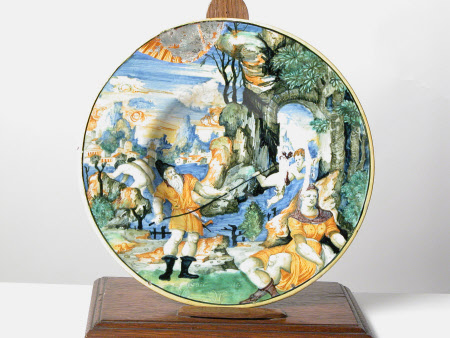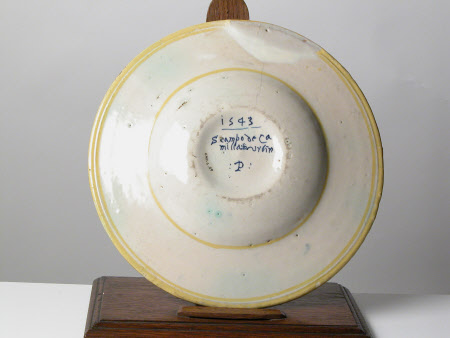Plate
Category
Ceramics
Date
1543
Materials
earthenware, tin-opacified lead glaze, polychrome pigments
Measurements
275 mm (Dia)
Order this imageCollection
Erddig, Wrexham
NT 1145573
Summary
Plate (tondino), tin-glazed earthenware (maiolica), small bowl with broad flat rim ('of cardinal's hat form'), possibly made in the workshop of Guido di Merlino, Urbino, Italy, dated 1543; decorated in colours and painted with an istoriato scene from Virgil's Aeneid, the Escape of Camilla; Diana sits at the lower right, while Metabus stands to her left, holding a lance or pike with his infant daughter Camilla tied to it with a ribbon, two nude figures bend towards the river, set within an extensive landscape beyond, with blue and ochre line bands at the rim; inscribed on the underside: '1543 | Scampo de Ca | milla in Urbin | : P : '.
Full description
Although damaged - repaired at the rim with a fragment from another dish - the inscription on the underside of this plate provides rare evidence of the year it was made '1543' and where 'in Urbin' or Urbino. The subject of the Escape of Camilla is also mentioned in the inscription, a story taken from Virgil's Aeneid, XI, vv. 539-827: driven from his throne, Metabus of the Volscians and his infant daughter Camilla were chased into the wilderness by armed Volsci. When the river Amasenus blocked his path, he bound her to a spear and promised Diana that Camilla would be her servant if she would safely transport her to the opposite bank. He then safely threw her to the other side, and swam across to retrieve her. J.V.G. Mallet discusses the 'Urbin:P:' mark in his 1978 article, noting that often more than one hand was involved in the decoration of istoriato (story painting) maiolica. He compares the overall painting with a dish at the Ashmolean Museum, Oxford, Abraham washing the feet of the Angels, inv. no. WA1947.191.264. The Ashmolean dish has been attributed by Professor Timothy Wilson to the workshop of Guido di Merlino, and perhaps painted by Guido Durantino. Mallet also notes the painter was evidently influenced by the work of Francesco Xanto Avelli, who painted several versions of this subject, particularly apparent in the pose of the father Metabus, which was copied from one of the figures in the Battle of the Romans and the Carthaginians, in a print by Marcantonio Raimondi or Marco Dente, see J.V.G. Mallet, 'Pottery and Porcelain at Erddig', Apollo, July 1978, pp.40-45; and discussed in Louisa Matilda Yorke, Facts and Fancies: A Description of Erthig, Denbighshire, 1920s, p. 14. The dish is listed in the 1914 inventory of the China and Pottery at Erthig (Erddig) : 'A very old and curious Round well-dish, representing a God and Goddess and Cupids. (rim cleverly repaired). Curious writing at the back dated 1543'.
Provenance
Given by Philip Yorke III (1905-1978) along with the estate, house and contents to the National Trust in 1973.
Marks and inscriptions
On the base: 1543 / Scampo de Ca / milla in Urbin / :P:

